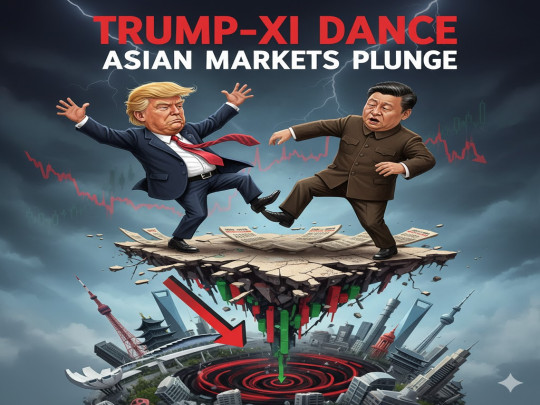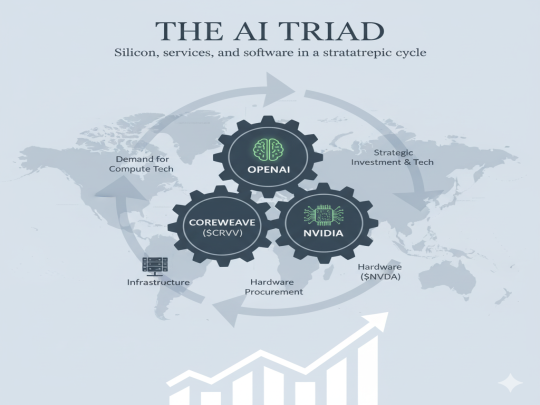Market Update: Wall Street Steady as Traders Eye U.S.-China Trade Talks and Tech Stocks Lead Early Gains
Nvidia leads U.S. equities higher as AI optimism fuels tech momentum. Dollar General jumps on strong guidance, while HPE, Thor, and Wells Fargo rally on earnings and regulatory shifts. Gold firms on trade fears, oil steadies, and Bitcoin stays flat. All eyes on upcoming U.S. jobs data and Fed's Beige Book.

- Early Tuesday US stock futures were little changed as investors awaited clarity from the second day of US-China trade talks in London.
- Monday's market closed mixed (S&P +0.09%, Nasdaq +0.31%), with the S&P 500 closing above 6,000 for the first time since February, led by strength in semiconductor stocks.
- Monday's session was highlighted by gains in semiconductors, with Qualcomm (+4%) up on its $2.4B acquisition of Alphawave. Warner Bros Discovery fell despite restructuring news.
- Notable premarket movers Tuesday included Apple (-0.3%) falling as its WWDC AI announcements underwhelmed. Tesla (+2.2%) rose after a public de-escalation between Trump and Musk. Designer Brands (-7.8%) and JM Smucker (-7.9%) dropped on earnings. Major drugmakers dipped after Health Sec. RFK Jr. ousted a CDC vaccine panel. McDonald's (-1.3%) fell on a downgrade citing weight-loss drug threats.
- Regarding trade, top US and Chinese officials are meeting in London to negotiate easing restrictions on mineral exports (rare earths) and potentially on US chip design software.
- Key economic data from the NY Fed's May survey showed a notable cooling in consumer inflation expectations, with the one-year outlook falling to 3.2%.
- Company news included Apple unveiling its "Apple Intelligence" platform and a redesigned "Liquid Glass" OS at WWDC. Paramount is conducting layoffs. IBM detailed its quantum computer roadmap.
- Global markets Tuesday saw Europe dip slightly. Asia finished mixed, with South Korea extending gains and Australia hitting a record, while China and Hong Kong were flat to lower.
- US Treasury yields ticked lower Tuesday morning (10-year around 4.456%) amid the ongoing US-China trade talks.
- Gold and Oil prices edged higher Tuesday on cautious optimism surrounding trade talks. Bitcoin rallied sharply as risk appetite improved.
- Market sentiment is cautiously optimistic, with traders watching for a positive outcome from the US-China talks as a potential catalyst for new highs. Focus now shifts to key US inflation data (CPI/PPI).
Stock futures were little changed on Tuesday as investors awaited further clarity on the status of trade discussions between the U.S. and China. The cautious tone followed a muted session on Wall Street, where market participants remained focused on negotiations between the world’s two largest economies. Talks are expected to resume Tuesday morning, and investors are hoping for signs of progress that could reduce tariff uncertainty and support corporate earnings going forward.
Monday saw modest gains across major indexes, with the S&P 500 edging slightly higher. The index continues to inch closer to its record high, now sitting just 2% below the all-time closing peak set in February. Monday’s advance came after all three major U.S. stock indexes logged their second consecutive weekly gain, suggesting growing optimism despite geopolitical headwinds.
Notably, the S&P 500 ended Friday’s session above the 6,000 mark for the first time since February 21, a psychological milestone that reinforced investor confidence. Market sentiment remains sensitive to developments in trade policy, with traders largely viewing high tariffs as a bargaining chip rather than a permanent fixture, a stance that has supported equity valuations in recent weeks.
US Market Previous Day:
U.S. markets posted mixed results on Monday, with the S&P 500 rising 0.09% to close at 6,005.88 and logging its second consecutive winning session. The Nasdaq Composite advanced 0.31%, ending the day at 19,591.24, while the Dow Jones Industrial Average slipped slightly by 1.11 points to finish at 42,761.76.
Semiconductor stocks were among the top gainers. Qualcomm surged more than 4% after announcing a $2.4 billion acquisition of semiconductor firm Alphawave, a move aimed at strengthening its position in the data center and AI chip markets. Advanced Micro Devices rose 4.8%, Texas Instruments added 3.5%, and Nvidia shares also ticked higher, contributing to overall strength in the tech sector. Chinese e-commerce giant Alibaba climbed 1.8%.
In contrast, shares of Warner Bros Discovery fell around 3% despite initially jumping nearly 13% following news that the company would restructure by separating its streaming and studio units from its struggling cable television operations. The early optimism gave way to investor concerns over the long-term impact of the reorganization.
Elsewhere, McDonald’s saw a modest decline after analysts at Morgan Stanley downgraded the stock, citing valuation concerns and slower international growth. Robinhood Markets slipped nearly 2% after S&P Dow Jones chose not to include the company in the latest reshuffling of the S&P 500, despite market speculation to the contrary.
US Futures Remain Flat:
- Dow Jones Industrial Average futures remained green with rise of 0.04%
- S&P 500 futures showed meagre gains of 0.15%
- Nasdaq Composite futures lead the pack with gains of 0.18%.
Biggest Premarket Movers
Apple: Stock fell 0.3%, continuing its losses from the previous session. The decline followed the keynote address at its annual developers' conference, where the company's unveiled "Apple Intelligence" features were seen by investors as incremental improvements rather than a revolutionary leap into AI.
Tesla: Stock rose 2.2% after President Donald Trump adopted a more neutral tone toward CEO Elon Musk during a press conference. This appeared to de-escalate tensions after a public falling out between the two last week.
Nvidia and Hewlett Packard Enterprise: Shares of Nvidia rose 0.3% while Hewlett Packard Enterprise gained 1.2%. The two technology companies announced they are partnering with Germany's Leibniz Supercomputing Centre to build a new supercomputer, which will utilize Nvidia’s next-generation "Vera Rubin" chips.
Designer Brands: Stock slumped 7.8% after the footwear retailer reported first-quarter earnings that fell short of analyst expectations. The company also withdrew its full-year guidance, citing the uncertain macroeconomic environment.
JM Smucker: Stock fell 7.9% after the consumer foods group missed its quarterly earnings forecast. The company flagged a "dynamic and evolving external environment" that has stemmed from recent global trade tensions.
McDonald’s: Stock fell 1.3% following a downgrade to “sell” from “buy” by the firm Redburn. The downgrade was based on the view that appetite-suppressing drugs pose an underestimated long-term threat to consumer demand for fast food.
Drugmakers (Moderna, Pfizer, GSK, AstraZeneca): Shares of these major pharmaceutical companies all slipped lower. The decline came after Health Secretary Robert F. Kennedy Jr. ousted all 17 members of a U.S. Centers for Disease Control and Prevention (CDC) expert panel on vaccines, a move that could potentially lengthen the approval timeline for new vaccines.
IBM: Stock rose 1% after the tech giant announced its detailed roadmap and plan to build and deliver a practical, large-scale, fault-tolerant quantum computer by 2029.
Walt Disney and Comcast: Disney's stock rose 0.2% and Comcast's stock gained 0.1%. The moves followed Disney's agreement to pay Comcast just over $438 million to acquire Comcast's remaining one-third stake in the streaming service Hulu, finalizing a long-standing arrangement.
Tariff Update:
Top U.S. trade officials met with their Chinese counterparts in London on Monday to continue negotiations aimed at easing tensions over mineral exports. Talks are expected to continue into Tuesday, with rare earth elements—a key input for electric vehicles and high-tech manufacturing—high on the U.S. agenda. According to U.S. National Economic Council Director Kevin Hassett, the goal is to persuade China to loosen its restrictions on these critical exports.
Last week, China appeared to signal a willingness to cooperate, offering temporary concessions to U.S. and European automakers. These moves were interpreted as an effort to de-escalate tensions and may indicate Beijing’s readiness to negotiate, albeit in exchange for reciprocal measures. The Chinese government has pushed back against Washington’s increased restrictions on exports of chip design software, and sources report President Trump has authorized Treasury Secretary Scott Bessent to consider easing those controls. Trump also mentioned receiving “good reports” from the U.S. negotiation team.
Key Economic Data/News:
Fresh data from the New York Federal Reserve suggests inflation expectations in the U.S. are beginning to cool. The one-year inflation outlook dropped to 3.2% in May, a notable 0.4 percentage point decline from April. Expectations for three years ahead dipped to 3%, while the five-year forecast eased slightly to 2.6% from 2.7%. While these figures remain above the Federal Reserve’s 2% target, they reflect improving sentiment as tariff-related pressures appear to be subsiding.
Earnings Season/Company News:
Apple’s annual Worldwide Developers Conference focused heavily on software, with the company unveiling a range of updates but offering few headline-grabbing surprises. The most notable announcement was a new operating system called “Liquid Glass,” which will redesign the interface across Apple’s product line—from iPhones to Macs—for the first time since 2013. The OS is set to be rolled out to consumers in the fall following a testing phase. Apple also introduced enhancements to Apple Music, such as lyric translation, and expanded gaming capabilities. New features were added for the Vision Pro headset as the company continues to invest in immersive technology.
Elsewhere in the media space, Paramount Global announced it would lay off approximately 3.5% of its workforce, with most affected employees being informed on Tuesday. The layoffs are part of a broader industry trend and come as Paramount prepares for a merger with Skydance Media. Other media giants, including Disney and Warner Bros. Discovery, have also reduced headcount recently as companies grapple with shifting consumption patterns and financial pressures tied to the transition from cable to streaming.
Global Market Trends:
European markets saw modest losses on Tuesday, with the Stoxx 600 index dipping 0.06%. The decline moderated after U.S. Commerce Secretary Howard Lutnick struck an optimistic tone about the ongoing trade discussions with China. European defense stocks were among the biggest laggards, with the regional Stoxx Aerospace and Defense index slipping 0.5%, marking a third consecutive day of losses despite strong year-to-date gains.
In the Asia-Pacific region, trading was mixed as investors monitored the second day of U.S.-China trade negotiations in London. Japan’s Nikkei 225 edged up 0.32% to close at 38,211.51, while the broader Topix was flat. South Korea’s Kospi rose 0.56%, marking its fifth consecutive session of gains, while the Kosdaq added 0.91%. Meanwhile, China’s CSI 300 index fell 0.51%, and Hong Kong’s Hang Seng Index ended flat. Australia’s S&P/ASX 200 advanced 0.84%, hitting a record high of 8,587.20.
Debt Market:
U.S. Treasury yields declined slightly as markets responded to the resumption of trade talks between the U.S. and China. The yield on the 10-year Treasury fell by nearly 3 basis points to 4.456%. The 2-year yield edged down to 3.993%, while the 30-year yield dropped 3 basis points to 4.921%. The moves suggest cautious optimism among investors as geopolitical tensions continue to influence fixed income markets.
Commodities and Other Assets:
Gold prices edged slightly higher on Tuesday as investors awaited more clarity from U.S.-China trade negotiations and looked ahead to key U.S. inflation data later this week. Market participants are closely watching for signs that could influence the Federal Reserve's next interest rate decision. While gold moved modestly, silver and platinum have recently outperformed, with both metals experiencing sharp gains in recent sessions. However, signs of profit-taking have begun to emerge as the rally in precious metals loses some momentum.
Oil prices also moved higher as the markets reacted positively to the progress in trade talks, which could signal improved demand prospects. On Monday, Brent crude had reached $67.19 per barrel—its highest level since April 28—on renewed hopes of a trade breakthrough. The rebound in oil prices has been supported by fading concerns over global demand, optimism over a potential trade resolution, and a favorable U.S. jobs report. Analysts at Goldman Sachs also pointed to possible disruptions in North American supply due to Canadian wildfires as another factor contributing to the upward pressure on prices.
Bitcoin rallied sharply on Tuesday, gaining as investors grew more optimistic about the U.S.-China trade negotiations and awaited upcoming inflation data in the U.S. The cryptocurrency had experienced range-bound trading in recent days, following a significant run-up to a record high of $112,000 last month. That rally was driven by increased institutional adoption and legislative support. However, escalating global trade tensions had since triggered a period of consolidation. The renewed hopes of a trade resolution have revived risk appetite and sent digital assets higher once again.
Market Sentiment:
Investor sentiment was cautiously optimistic heading into the midweek, with JPMorgan noting that the S&P 500—just 2% below its February peak as of Tuesday morning in Asia—could break to a new all-time high if U.S.-China trade talks proceed positively. Traders appeared to be taking bullish positions in Chinese large-cap equities and U.S. semiconductor stocks, both seen as major beneficiaries of improved trade relations between the two countries.
Still, advancing bond yields may temper some of that enthusiasm. With U.S. inflation data due later in the week, including the Consumer Price Index (CPI) on Wednesday and the Producer Price Index (PPI) on Thursday, traders are closely watching for signs of how tariffs and supply chain issues may be filtering through to consumer and producer prices. The results could influence both equity markets and expectations for the Fed's policy trajectory in the months ahead.



